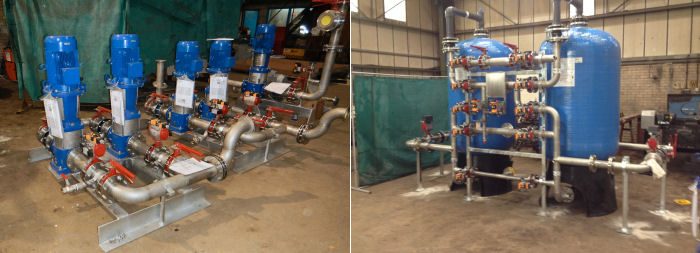Fairport’s Off Site Module Fabrication Gives Clients Win : Win Solutions
Food Industry
FEL was commissioned by a major food manufacturer to design a small water treatment plant to enhance the quality and supply of potable water to one of their processing plants by vastly reducing the iron content. The treatment plant consisted of an inlet surge tank, filtration plant, conditioned water buffer tank and high lift distribution pumps. The filtration plant was fully automatically controlled by the water demand of the processing plant and included automatic backwashing of the filters, when required, without interruption to the overall potable water demand.

The plant was designed in modules to greatly reduce the installation time on site. Splitting the plant into small ‘skid-type’ units meant that much of the intricate piping and valves could be prefabricated and tested prior to delivery. The individual skids, incorporating valves and instrumentation, were then simply connected by lengths of piping. The heart of the filtration plant consisted of twin pressure filters operating in parallel with manganese rich media. The plant was fully automated and controlled with a bespoke PLC system and HMI to maintain the average water demand and ensure a balance of flow between the filters. Key process pumps and valves are continuously monitored and in the event of pump or valve failure the process will automatically swap to standby pumps to maintain a very high availability.
Chemical Industry
FEL were separately commissioned by an international chemical producer to design a liquid colouring dye dosing unit as part of a larger manufacturing plant. Several factors influenced the overall design and build, the prime being the extreme high cost of the raw concentrate dye and the accuracy of the dosing that was required. There were strict product colour tolerances which meant that the dye makeup and dosing had to be achieved with high accuracy (+/- 0.5% over the full operating range). The unit consists of an IBC feed system to meter the concentrate dye into a premix tank. The premix tank diluted the concentrate into the required ratio with water (to a high tolerance). After mixing the prepared dye is automatically transferred to a day tank for use. The dye makeup, transfer and final metering into the process was controlled by a PLC and HMI system allowing the operator to simply alter the dye ratio if required and the rate of dosing.

The complete dosing skid was manufactured in a standalone bund to enable ease of installation and testing and prewiring of major components. Tank levels were monitored by means of load cells to cross check dosing rates and continuously monitor levels to allow complete automation and a effectively provide a continuous dosing unit from a batch make up system.
For further information please contact our Communications Manager.

